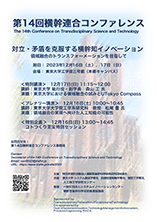Current issue
Displaying 51-78 of 78 articles from this issue
-
Session ID: B-3
Published: 2023
Released on J-STAGE: March 07, 2024
Download PDF (484K) -
Session ID: B-3
Published: 2023
Released on J-STAGE: March 07, 2024
Download PDF (3219K) -
Session ID: B-3
Published: 2023
Released on J-STAGE: March 07, 2024
Download PDF (796K) -
Session ID: B-3
Published: 2023
Released on J-STAGE: March 07, 2024
Download PDF (4270K) -
Session ID: B-3
Published: 2023
Released on J-STAGE: March 07, 2024
Download PDF (304K) -
Session ID: B-3
Published: 2023
Released on J-STAGE: March 07, 2024
Download PDF (575K)
-
Session ID: C-3
Published: 2023
Released on J-STAGE: March 07, 2024
Download PDF (672K) -
Session ID: C-3
Published: 2023
Released on J-STAGE: March 07, 2024
Download PDF (786K) -
Session ID: C-3
Published: 2023
Released on J-STAGE: March 07, 2024
Download PDF (1190K)
-
Session ID: E-3
Published: 2023
Released on J-STAGE: March 07, 2024
Download PDF (719K) -
Session ID: E-3
Published: 2023
Released on J-STAGE: March 07, 2024
Download PDF (291K) -
Session ID: E-3
Published: 2023
Released on J-STAGE: March 07, 2024
Download PDF (4726K) -
Session ID: E-3
Published: 2023
Released on J-STAGE: March 07, 2024
Download PDF (943K)
-
Session ID: A-4
Published: 2023
Released on J-STAGE: March 07, 2024
Download PDF (542K)
-
Session ID: B-4
Published: 2023
Released on J-STAGE: March 07, 2024
Download PDF (185K) -
Session ID: B-4
Published: 2023
Released on J-STAGE: March 07, 2024
Download PDF (1529K) -
Session ID: B-4
Published: 2023
Released on J-STAGE: March 07, 2024
Download PDF (703K) -
Session ID: B-4
Published: 2023
Released on J-STAGE: March 07, 2024
Download PDF (500K) -
Session ID: B-4
Published: 2023
Released on J-STAGE: March 07, 2024
Download PDF (782K)
-
Session ID: C-4
Published: 2023
Released on J-STAGE: March 07, 2024
Download PDF (438K) -
Session ID: C-4
Published: 2023
Released on J-STAGE: March 07, 2024
Download PDF (349K) -
Session ID: C-4
Published: 2023
Released on J-STAGE: March 07, 2024
Download PDF (212K) -
Session ID: C-4
Published: 2023
Released on J-STAGE: March 07, 2024
Download PDF (798K)
-
Session ID: D-4
Published: 2023
Released on J-STAGE: March 07, 2024
Download PDF (500K) -
Session ID: D-4
Published: 2023
Released on J-STAGE: March 07, 2024
Download PDF (419K) -
Session ID: D-4
Published: 2023
Released on J-STAGE: March 07, 2024
Download PDF (510K) -
Session ID: D-4
Published: 2023
Released on J-STAGE: March 07, 2024
Download PDF (476K) -
Session ID: D-4
Published: 2023
Released on J-STAGE: March 07, 2024
Download PDF (677K)
